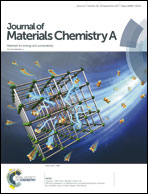Graphene-based carbon coated tin oxide as a lithium ion battery anode material with high performance†
Abstract
In this study, we synthesized an excellent ternary graphene-based carbon coated SnO2 (rGO/PC/SnO2) nanocomposite anode for lithium ion batteries (LIBs), in which carbon-coated SnO2 nanoparticles homogeneously grow on the surface of reduced graphene oxide (rGO) using glucose as the soft templating agent. Using glucose can limit the growth of the SnO2 particles; as a result, the size of the SnO2 particles would be relatively uniform. Moreover, the carbon coated on the surface of SnO2 particles can effectively prevent their agglomeration on the surface of rGO and limit their volume expansion during charge–discharge cycles. The porous structure of the rGO/PC/SnO2 nanocomposite can effectively accommodate the severe volume variation upon cycling and provide additional contact areas between the active material and the electrolyte. Significantly, the rGO/PC/SnO2 anode delivers an initial specific discharge capacity of 2238.2 mA h g−1 and retains 1467.8 mA h g−1 after 150 cycles at a current density of 0.1C (1C = 782 mA g−1). Even at the high specific current of 1C after 200 cycles, the reversible specific capacity is still as high as 618.3 mA h g−1. The rGO/PC/SnO2 anode exhibits excellent rate performances and possesses a reversible specific capacity of 445.9 mA h g−1 at 5C implying its good structural stability.



 Please wait while we load your content...
Please wait while we load your content...